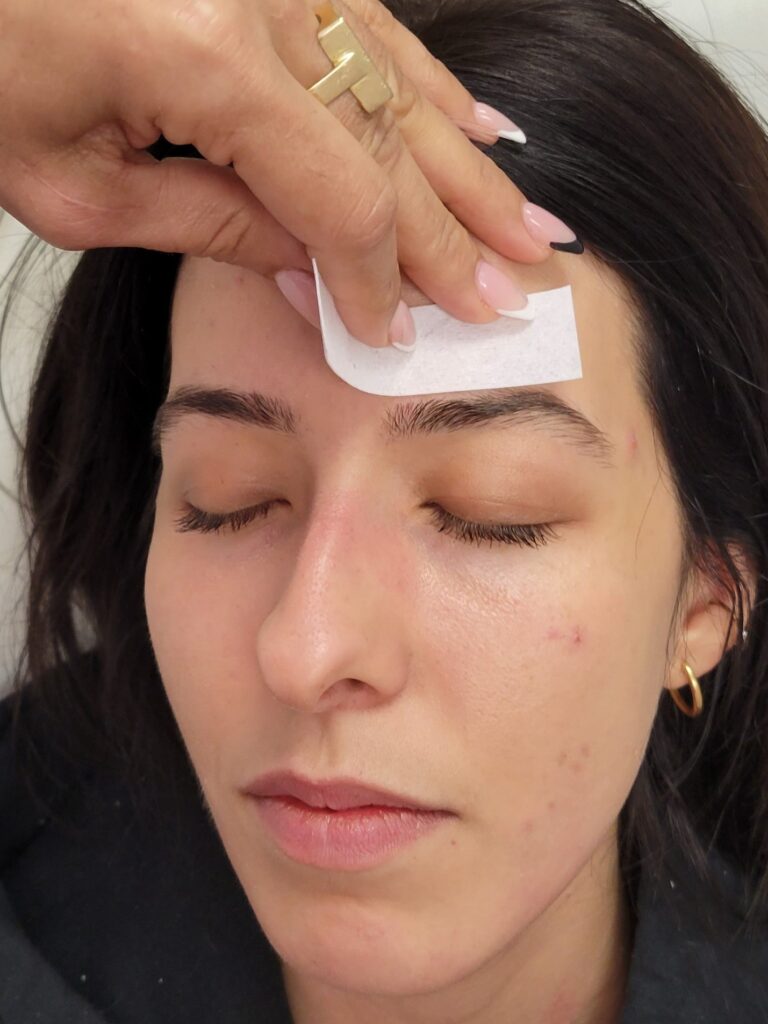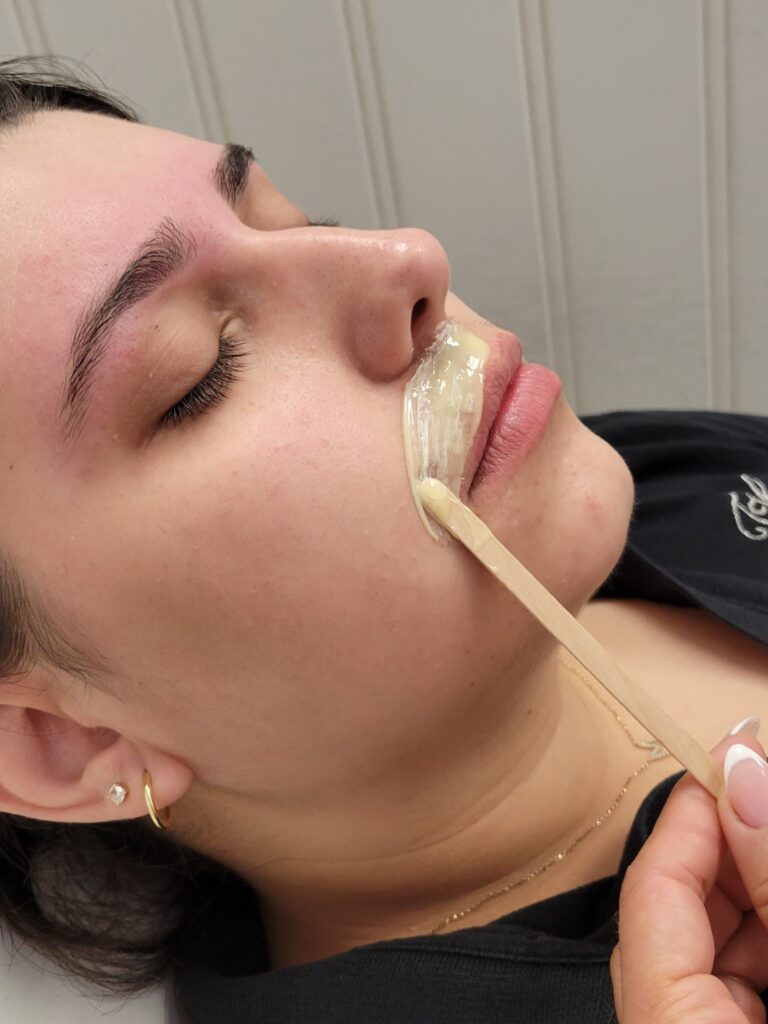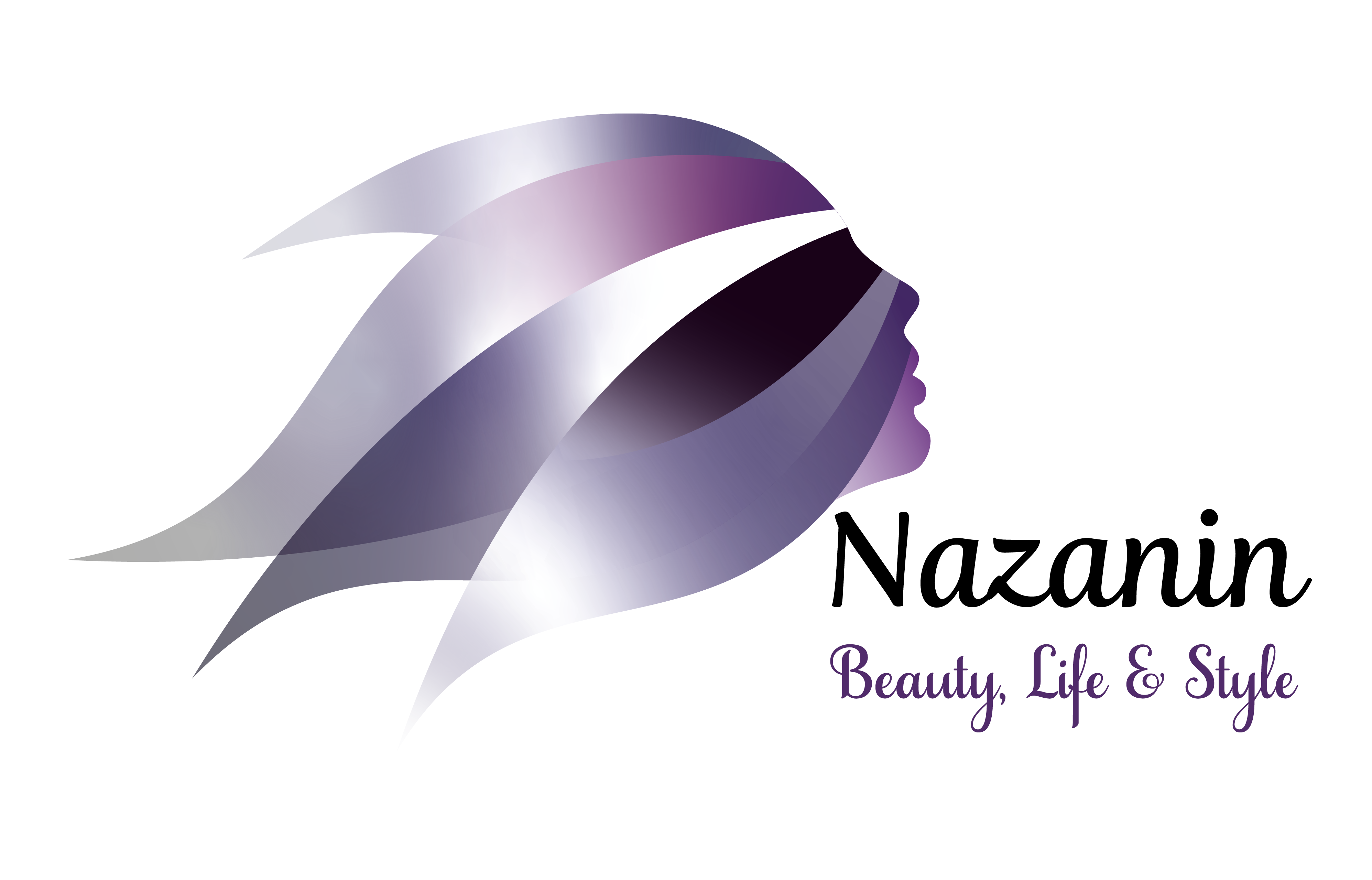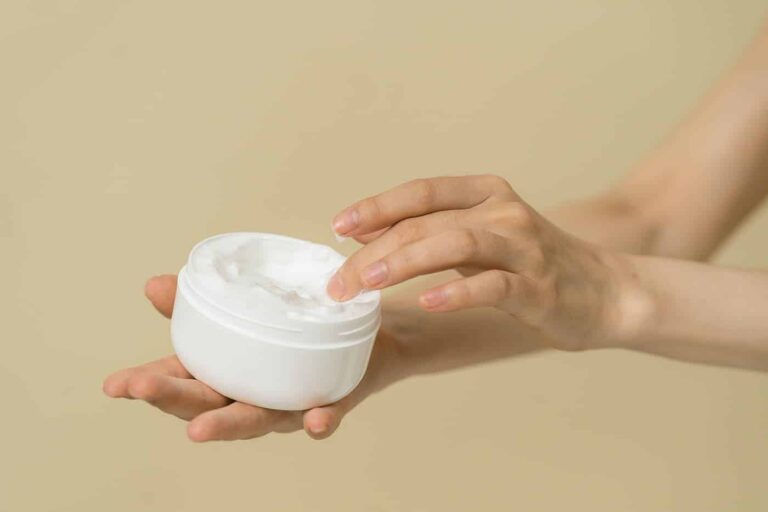What is Waxing Eyebrows
Waxing eyebrows is a popular method of eyebrow grooming and hair removal. It involves applying a layer of warm or cold wax to the unwanted hair on and around the eyebrows and then swiftly removing the wax along with the hair using a cloth strip or by pulling the wax directly.

Here’s an overview of the process of eyebrow waxing:
- Preparation: Before the waxing procedure, the esthetician will clean the eyebrow area and potentially trim any excessively long hairs. They may also apply a light dusting of talcum powder to ensure the wax adheres properly to the hair.
- Wax application: The esthetician will apply warm or cold wax to the desired area using a disposable spatula or applicator. The wax is typically spread in the direction of hair growth, following the natural shape of the eyebrows.
- Wax removal: Once the wax has set slightly and adhered to the hair, the esthetician will swiftly remove it. This is typically done by pulling off the wax with a cloth strip or by directly pulling the wax itself. The removal is done in the opposite direction of hair growth.
- Soothing and aftercare: To soothe the skin and reduce any post-waxing redness or irritation, the esthetician may apply a cooling gel, aloe vera, or a calming lotion. They may also provide aftercare instructions on how to care for the waxed area in the following days.
Eyebrow waxing offers several benefits, including quick and efficient hair removal, longer-lasting results compared to tweezing, and the ability to shape and define the eyebrows precisely. However, it’s important to note that waxing may cause temporary redness or irritation, especially for those with sensitive skin. It’s advisable to consult with a trained esthetician or professional to ensure proper technique and minimize the risk of adverse reactions.
Before and after eyebrow waxing, it’s generally recommended to avoid sun exposure, harsh skincare products, and excessive touching or rubbing of the waxed area to prevent irritation. Following the esthetician’s aftercare instructions can help maintain the results and promote skin healing.
Before and after getting your eyebrows waxed, you can follow these guidelines for optimal results and care:
Before Eyebrow Waxing:
- Allow hair growth: Ensure that your eyebrows have enough hair growth before waxing. Avoid tweezing or trimming your eyebrows for at least two to three weeks beforehand. This allows the wax to effectively adhere to the hair for efficient removal.
- Cleanse your skin: Before your appointment, cleanse your face and eyebrows thoroughly to remove any makeup, oils, or dirt. This helps create a clean surface and ensures better adherence of the wax.
- Communicate your desired shape: Have a clear idea of how you want your eyebrows to be shaped. You can bring reference pictures or describe your preferences to the esthetician. Clear communication ensures that you both have a shared understanding of the desired outcome.
After Eyebrow Waxing:
- Avoid touching or rubbing the area: After waxing, your skin may be sensitive. Avoid touching or rubbing the waxed area to minimize the risk of irritation or infection.
- Apply a soothing product: To calm the skin and reduce any redness or irritation, you can apply a soothing gel, aloe Vera gel, or a post-waxing lotion recommended by the esthetician. These products can help hydrate and soothe the skin.
- Avoid applying makeup or using harsh products: It’s generally recommended to avoid applying makeup or using harsh skincare products on the waxed area immediately after the procedure. This allows the skin to breathe and heal properly. If you must use makeup, wait for a few hours after waxing to minimize the risk of clogging the hair follicles or causing further irritation.
- Protect the area from the sun: The waxed area may be more sensitive to sun exposure. If you have to be outside, consider wearing a hat or using sunscreen to protect your eyebrows from harmful UV rays.
- Follow the esthetician’s aftercare instructions: The esthetician may provide specific aftercare instructions based on your skin type and the extent of waxing. Follow their guidance regarding cleansing, moisturizing, and any other recommended steps to ensure proper healing and maintain the shape of your eyebrows.
Remember, everyone’s skin reacts differently, so it’s possible to experience mild redness or sensitivity after waxing. However, if you notice severe pain, prolonged redness, or any signs of infection, it’s advisable to seek professional advice from a dermatologist or the esthetician who performed the waxing.
Difference between Eyebrow Waxing and Treading
Eyebrow waxing and threading are two distinct methods of eyebrow grooming and hair removal, differing in technique, precision, discomfort level, and other factors. Here are the main differences between eyebrow waxing and threading:
- Technique: Eyebrow waxing involves applying a layer of warm or cold wax to the unwanted hair on and around the eyebrows, allowing it to adhere to the hair, and then swiftly removing the wax along with the hair. Eyebrow threading, on the other hand, uses a twisted cotton thread to trap and remove unwanted hair by pulling it out from the root.
- Precision: Threading offers more precise control over shaping the eyebrows. The threading specialist can target individual hairs, allowing for a more defined and precise shape. Waxing, on the other hand, removes hair in larger sections, making it less precise for shaping.
- Hair Removal: Threading removes hair from the follicle by pulling it out at the root. This can result in longer-lasting results compared to waxing, which removes hair from the surface of the skin. Waxing may leave some hair behind, requiring more frequent touch-ups.
- Discomfort: The level of discomfort can vary between waxing and threading depending on individual pain tolerance. Some people find threading to be less painful because it only targets individual hairs. However, others may find the quick pulling motion of waxing to be more uncomfortable.
- Skin Sensitivity: Threading is generally considered to be a gentler option for individuals with sensitive skin. The process does not involve the use of any chemicals or products, reducing the risk of skin irritation or allergic reactions. Waxing, on the other hand, involves applying wax on the skin, which may cause temporary redness or irritation, particularly for those with sensitive skin.
- Regrowth: Since threading removes hair from the root, the regrowth tends to be slower compared to waxing. With waxing, the hair typically grows back within a few weeks, while threading can keep the eyebrows looking groomed for a longer duration.
Ultimately, the choice between eyebrow waxing and threading comes down to personal preference, skin sensitivity, and desired results. Some individuals may prefer threading for its precision and gentler approach, while others may opt for waxing if they prefer faster hair removal or have less sensitive skin. It’s important to consider your individual needs and consult with a professional to determine the best option for you.
Upper lip/ mustache waxing
Upper lip waxing is a common method of hair removal for the area above the lip, also known as the mustache area. It involves applying a layer of warm or cold wax to the upper lip, allowing it to adhere to the unwanted hair, and then swiftly removing the wax along with the hair.

Here are some guidelines to follow before and after upper lip waxing:
Before Upper Lip Waxing:
- Check hair length: Ensure that the hair in the upper lip area is long enough for effective waxing. Ideally, it should be about 1/4 inch long. If the hair is too short, it may not adhere well to the wax.
- Cleanse the area: Cleanse your upper lip area thoroughly before waxing to remove any makeup, oils, or dirt. This helps create a clean surface for the wax to adhere to and ensures better hair removal.
- Avoid skincare products: Refrain from using any skincare products, such as creams, lotions, or serums, on the upper lip area before waxing. These products can create a barrier between the hair and the wax, making it less effective.

During and After Upper Lip Waxing:
- Seek professional help: It’s generally recommended to have upper lip waxing performed by a trained esthetician or waxing specialist. They have the expertise to apply the wax properly and remove it swiftly, minimizing discomfort and maximizing effectiveness.
- Communicate your preferences: Before the waxing procedure, communicate any concerns or specific requests you may have to the esthetician. This helps ensure that they understand your expectations and can tailor the waxing process accordingly.
- Take care of the area afterward: After waxing, the esthetician may apply a cooling gel or lotion to soothe the skin and reduce any redness or irritation. Follow their aftercare instructions, which may include avoiding sun exposure, applying soothing products, and refraining from using makeup or harsh skincare products on the waxed area for a specified period.
- Avoid heat or friction: Immediately after waxing, avoid activities that could cause excessive heat or friction to the waxed area. This includes hot showers, saunas, steam rooms, or vigorous rubbing of the skin. Such activities can irritate the skin and increase the chances of post-waxing redness or sensitivity.
- Maintain proper skincare: In the days following waxing, continue to care for the waxed area by cleansing gently, moisturizing, and protecting it from excessive sun exposure. Use mild and non-irritating products that are suitable for your skin type.
- Schedule follow-up appointments: The regrowth of hair varies for each individual. Depending on your hair growth rate, you may need to schedule follow-up waxing appointments every few weeks to maintain the desired hair-free result.
It’s important to note that some individuals may experience temporary redness, sensitivity, or minor discomfort after upper lip waxing. However, if you have severe pain, prolonged redness, or signs of infection, it’s advisable to consult with a professional esthetician or dermatologist for appropriate advice and care.
Full Face waxing
Full face waxing is a method of hair removal that involves waxing the hair on the entire face, including the eyebrows, upper lip, chin, cheeks, sideburns, and forehead. It is a comprehensive approach to facial hair removal, providing a smooth and hair-free appearance.
The process of full face waxing typically includes the following steps:
- Preparation: Before waxing, the esthetician cleanses the face to remove any makeup, oils, or dirt. This ensures a clean surface for the wax to adhere to and enhances hair removal.
- Application of wax: The esthetician applies warm or cold wax to different areas of the face using a disposable spatula or applicator. They typically work in small sections, applying the wax in the direction of hair growth.
- Wax removal: Once the wax has slightly cooled and adhered to the hair, the esthetician swiftly removes it. This is usually done by pulling off the wax along with the hair using cloth strips or by directly pulling the wax itself. The removal is typically done against the direction of hair growth.
- Tweezing and shaping: After waxing, the esthetician may use tweezers to pluck any stray hairs or to refine the shape of the eyebrows further. This step helps achieve a clean and defined look.
- Soothing and aftercare: After the waxing procedure, the esthetician may apply a cooling gel or soothing lotion to calm the skin and reduce any redness or irritation. They may also provide aftercare instructions on how to care for the waxed area in the following days.
Full face waxing is suitable for individuals who prefer a more comprehensive approach to facial hair removal or those who have noticeable hair growth on various areas of the face. It offers the advantage of removing hair from multiple facial areas in a single session, providing a more uniform and groomed appearance.
However, it’s important to note that waxing may cause temporary redness, sensitivity, or slight discomfort, particularly for those with sensitive skin. It’s advisable to consult with a trained esthetician or professional to ensure proper technique and minimize the risk of adverse reactions.
Before and after full face waxing, it’s generally recommended to avoid sun exposure, harsh skincare products, and excessive touching or rubbing of the waxed area to prevent further irritation. Following the esthetician’s aftercare instructions can help maintain the results and promote proper healing of the skin.

